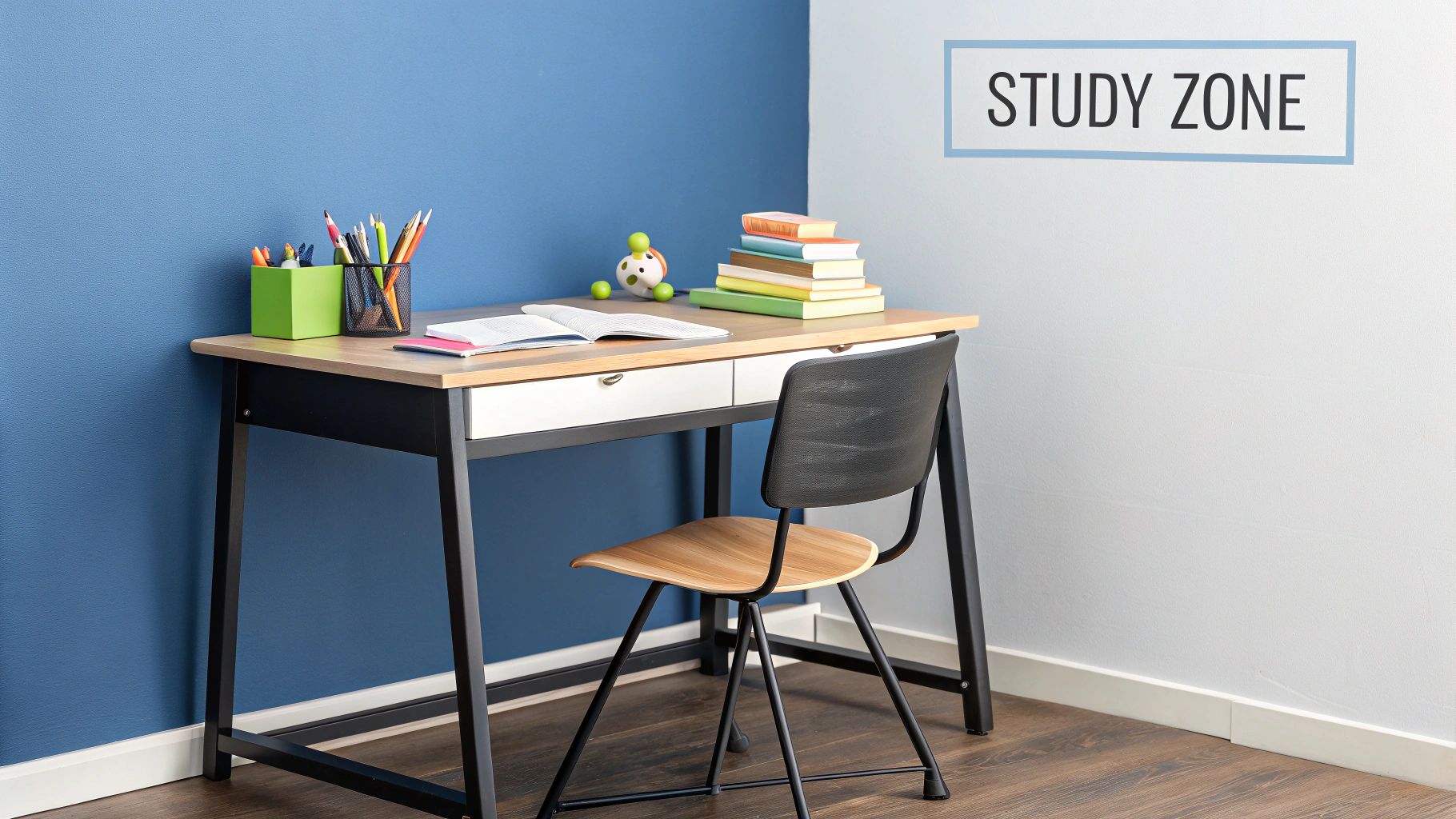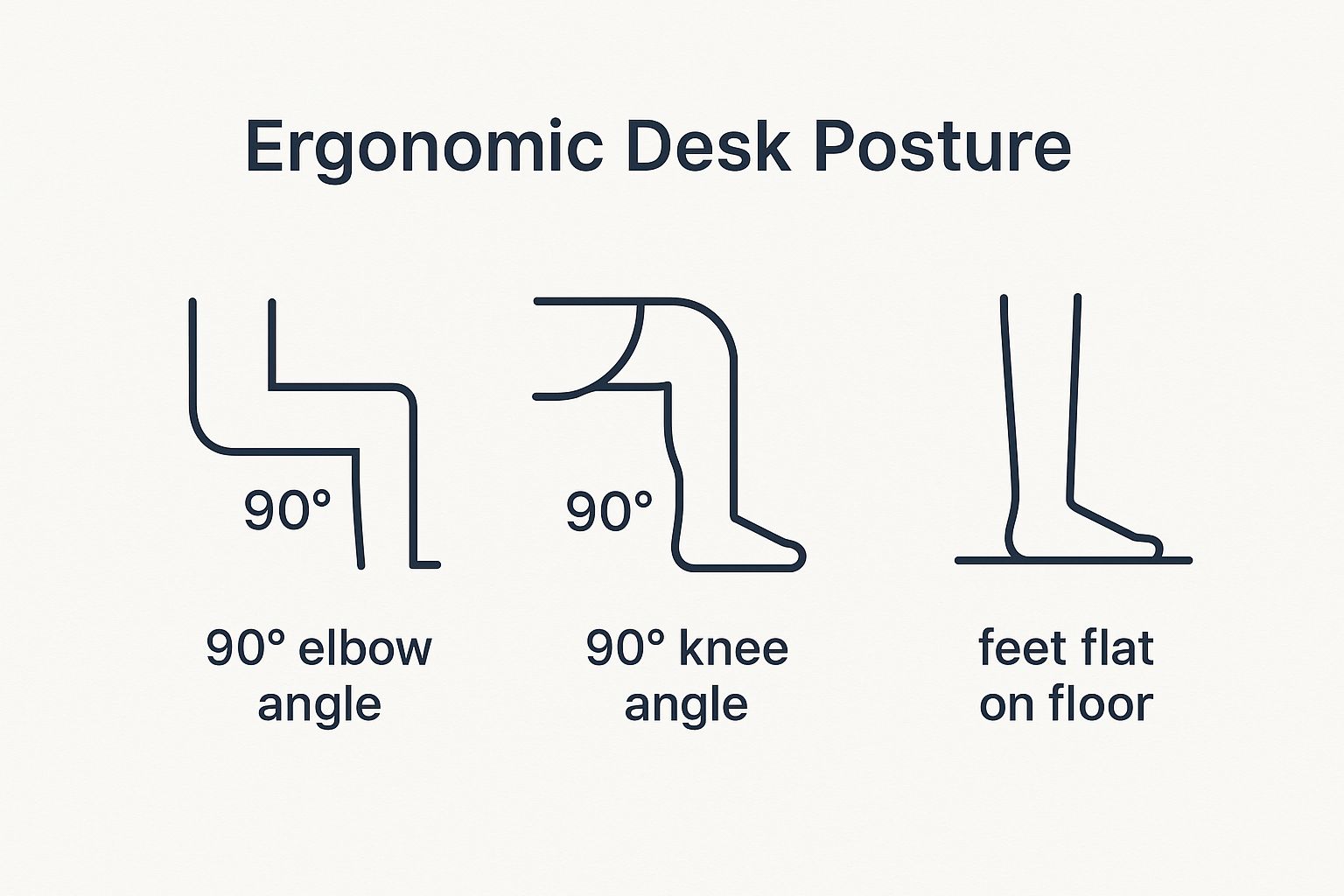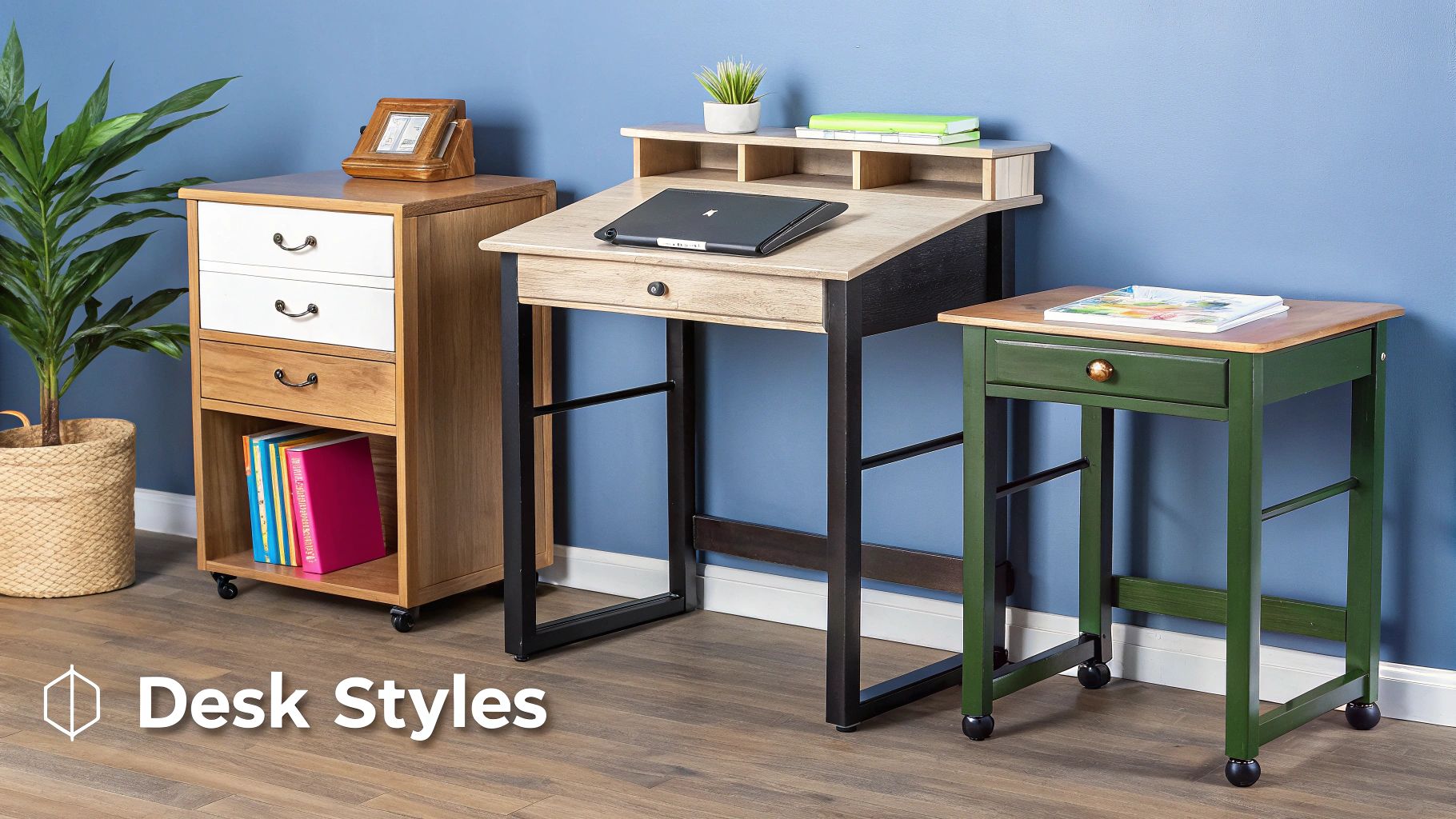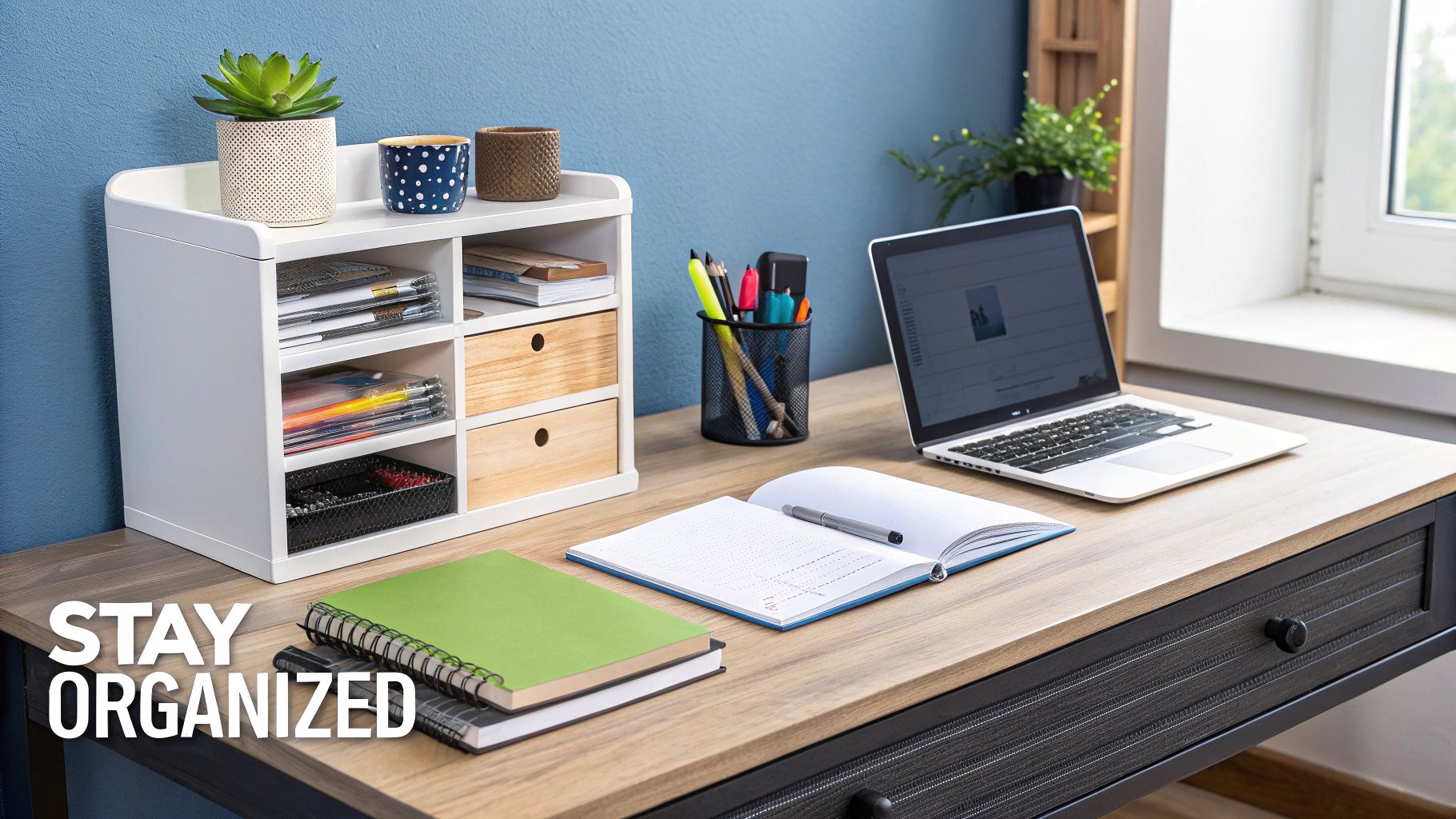
Choosing the Best Childrens Homework Desks
Share
A good homework desk is so much more than a piece of furniture. Think of it as a dedicated zone that quietly signals to your child, "it's time to focus." This simple addition to their room can be the starting point for building crucial habits like organization, time management, and a sense of academic discipline.
How a Dedicated Desk Transforms Homework Time

We've all been there: the nightly scramble to clear a spot at the kitchen table. Homework papers get mixed up with dinner plates, and constant interruptions shatter any chance of concentration. A dedicated desk puts an end to that chaos. It creates a predictable, personal space for learning, acting as a powerful psychological cue for a child to switch from playtime to study mode.
This shift is a game-changer for developing solid academic routines. When a child has a designated spot for their books, supplies, and projects, they start to take real ownership of their work. It's amazing how this fosters a sense of responsibility and independence that goes far beyond just getting assignments done.
Building Foundational Habits Early
A proper desk is essentially a child's first real workspace, and it's where they learn incredibly valuable organizational skills. With their own drawers or shelves, they figure out how to keep supplies tidy and within reach. This cuts down on the frustration of hunting for a pencil or an eraser, making the simple act of starting homework a much smoother process.
It seems parents everywhere are catching on. The global market for children's home study desks was valued at around USD 1.2 billion and is projected to more than double by 2033. This shows a clear trend toward creating more effective study environments at home.
The benefits of a structured study area aren't just about keeping things neat; they lay a foundation for future success by building habits that will last a lifetime. Some of the key advantages include:
- Improved Focus: A dedicated spot, free from the distractions of toys or the TV, helps sharpen concentration.
- Better Posture and Health: An ergonomic desk is designed to support a growing body, preventing slouching and discomfort.
- Enhanced Organization: Having a specific home for school materials teaches kids how to manage their belongings.
- A Sense of Ownership: A personal desk gives a child a sense of pride and control over their learning environment.
A child’s desk is not just a place for homework. It is a launchpad for creativity, a quiet corner for concentration, and the first step in building a lifelong love of learning.
Ultimately, investing in the right childrens homework desks is an investment in your child's entire academic journey. It lays the groundwork for success by creating a space that is both functional and inspiring. Getting these principles right for younger children can be especially powerful; our guide on preschool room design ideas offers more tips on creating effective learning spaces from the very beginning. This guide will walk you through everything you need to know.
Mastering Ergonomics for Growing Kids
Think of a homework desk like a pair of running shoes for a young athlete. If the shoes are too big or small, they don’t just feel awkward—they can cause discomfort, lead to poor form, and ultimately hurt their performance. The same idea applies to your child’s study space. The right fit is everything for their comfort, focus, and long-term health.
This concept of "proper fit" in a workspace is called ergonomics. For kids, it's not just a nice-to-have feature; it's absolutely critical for building healthy postural habits while they're still growing. An ergonomic setup makes sure the desk and chair work with their body, not against it.
A poorly designed study area is a recipe for fidgeting, slouching, and physical strain. These little discomforts are major distractions that can quickly send a productive homework session off the rails. By getting a handle on a few simple ergonomic rules, you can create a space that supports their growing body and helps them stay sharp.
The Foundation of Good Posture: The 90-Degree Rule
The cornerstone of ergonomics for kids is the "90-degree rule." It’s a super simple guideline to make sure your child’s body is properly aligned and supported while they sit. Just picture right angles at their key joints—that’s the sweet spot for comfort and sustained focus.
To get there, you'll want to check three things:
- Elbows: They should be bent at a 90-degree angle, allowing their forearms to rest comfortably on the desk. No hunched shoulders allowed!
- Knees: Their knees should also be at a 90-degree angle, with thighs parallel to the floor.
- Feet: This one's important—their feet must rest flat on the floor or on a footrest.
Dangling feet are a big no-no. They can put pressure on the back of their thighs, mess with circulation, and cause them to squirm around trying to get comfortable. When these three points are aligned, you’ve created a stable, supportive base for learning.
This infographic breaks it down visually.

Keeping these 90-degree angles in mind for elbows and knees while making sure their feet are flat gives you a clear, actionable checklist for setting up any study space.
Why Adjustable Desks Are the Smartest Investment
Kids grow like weeds. A desk that fits them perfectly today might be comically small in six months. This is where adjustable childrens homework desks really shine. They're designed to adapt, giving you a long-term solution that grows right alongside your child, from their first spelling tests to their high school finals.
An adjustable desk lets you fine-tune the height to maintain that perfect 90-degree elbow angle, no matter how much they’ve shot up. Pair it with an adjustable chair, and you’ve got a fully customized ergonomic setup that will last for years. It ends up being a much smarter and more economical choice in the long run.
Parents are catching on. The global market for children's adjustable ergonomic desks was valued at around USD 1.15 billion in 2021 and is projected to hit USD 1.62 billion by 2025. That’s a huge jump, and it shows just how much parents are prioritizing long-term comfort and health for their kids.
A child’s comfort is directly linked to their ability to concentrate. An ergonomic workspace removes physical distractions, freeing up mental energy for learning and problem-solving.
These same principles apply even to the littlest learners at their first activity table. If you're curious, you might want to check out our guide on choosing the right Montessori table and chair, which dives into creating spaces that foster independence from a young age.
At the end of the day, good ergonomics is all about creating an environment that supports health and focus. When you get their desk set up correctly, you’re not just giving them a place for homework—you’re investing in their well-being and setting them up for success.
Finding the Right Desk Type for Your Space

Alright, you’ve got the ergonomics down. Now for the fun part: picking a desk style that actually fits your home and your kid’s personality. This isn't just about finding something that looks nice; it’s like picking the perfect tool for a job. What works for a first-grader with simple math sheets won't cut it for a middle schooler building a science fair project.
The goal here is to find a piece of furniture that feels like a natural part of your family’s life while also being a genuine hub for learning. Let's look past a simple list and dive into what each style really means for your day-to-day.
The Classic Writing Desk
Simple, timeless, and for a good reason. The traditional writing desk gets the job done without any fuss. Think of it as the reliable family sedan—it’s not flashy, but it’s incredibly practical for everyday homework.
These desks usually have a clean, flat top and maybe a drawer or two for pencils and paper. Their no-nonsense design is a huge plus for minimizing distractions, making them a fantastic starting point for younger kids just getting into the rhythm of homework. They slip easily into a bedroom corner or a nook in the living room without taking over.
- Best For: Younger elementary students, straightforward homework, and smaller rooms.
- Pros: Compact, usually affordable, and its minimalist design helps keep kids focused.
- Cons: The limited storage and surface area can become a problem as projects get bigger and messier in later grades.
The Corner-Saving L-Shaped Desk
When every square inch of a room counts, the L-shaped desk is a game-changer. By fitting neatly into a corner, it instantly creates two distinct work surfaces. It's like getting two desks in one without gobbling up the whole floor.
This setup is perfect for kids who need to spread out. One side can be for the laptop or tablet, while the other is dedicated to drawing, writing, or hands-on projects. It's a natural way to encourage organization and is a solid choice for middle schoolers juggling multiple subjects.
The Future-Proof Height-Adjustable Desk
If you’re playing the long game and want something that puts ergonomics first, the height-adjustable desk is the undisputed champion. This is the ultimate "grow-with-me" piece, adapting perfectly from kindergarten crayons to high school exams.
While they cost more upfront, they often save you money over time since you won’t need to buy a new desk every few years. Many even convert to standing desks, which is a fantastic way to encourage kids to move around and break up those long study sessions.
The ability to adjust a desk to a child's precise height isn't a luxury; it's fundamental to creating a healthy study spot that prevents strain and keeps them focused.
This idea of adaptable furniture is important at any age. For those with even younger kids, getting the right table and chairs set for kids can instill good posture habits from the very beginning.
The Space-Smart Loft Bed Desk
For anyone tight on space, the loft bed with a built-in desk underneath is a stroke of genius. Lifting the bed frees up the entire footprint below for a complete study zone. It's an all-in-one command center for sleeping, studying, and just hanging out.
This design is a lifesaver in small or shared bedrooms. It gives a child their own distinct areas for rest and work, all within one compact unit. Just be sure the ladder is sturdy and safe, and consider adding extra lighting, as the area under the bunk can be a bit dark.
Desk Type Comparison for Different Needs
Feeling a little overwhelmed by the options? Not to worry. This quick-glance table breaks down the key features of each desk type, making it easier to see which one might be the best match for your child and your home.
| Desk Type | Best For | Space Efficiency | Adjustability | Built-in Storage |
|---|---|---|---|---|
| Classic Writing | Young kids & simple tasks | High | Low | Minimal |
| L-Shaped | Multitasking & bigger projects | Medium | Low | Varies |
| Height-Adjustable | All ages & long-term use | High | High | Varies |
| Loft Bed Desk | Small rooms & all-in-one setup | Very High | Low | Moderate |
Ultimately, the best desk is one that feels like a supportive and inviting space for your child. By considering their age, study habits, and the room you have available, you can choose a desk that will serve them well for years to come.
What's It Made Of? A Look at Desk Materials and Safety
When you're picking out furniture for your child, your brain immediately kicks into safety-inspector mode. Is it sturdy? Could it tip over? Are the materials actually safe? These questions are front and center when choosing a childrens homework desk, since it's a spot where your kid will spend countless hours.
Think of it like picking out ingredients for dinner. You want wholesome, quality stuff that's safe. The same logic applies here. Let's break down exactly what to look for to make sure the desk you choose is both built to last and completely safe.
The Non-Negotiable Safety Checklist
Before we even get into the wood, metal, or plastic, there are a few safety details that are absolutely essential. These are the little things that prevent bumps, bruises, and bigger accidents, turning a simple piece of furniture into a secure study station.
Here’s what should be on your list:
- Rounded Corners and Edges: Sharp corners are basically magnets for accidents. Look for desks with smoothly rounded or beveled edges to minimize ouchies from bumps, especially if you have an active younger kiddo.
- Non-Toxic, Low-VOC Finishes: Indoor air quality is a big deal. Volatile Organic Compounds (VOCs) are chemicals that paints and finishes can release into the air, and you don't want your child breathing them in. Always check for desks with non-toxic, low-VOC or zero-VOC finishes to keep the air in their room clean.
- Anti-Tip Hardware: This is a huge one. Kids are climbers, and an open drawer can look a lot like a step ladder. Anti-tip kits, which anchor the desk to the wall, are a critical feature to stop it from toppling over.
These aren't just minor details—they're fundamental to creating a truly child-friendly space you can feel good about.
A Guide to Common Desk Materials
Now, let's talk about what the desk is actually made of. The material determines everything from durability and weight to how it looks and what it costs. Getting a handle on the pros and cons of each will help you strike the perfect balance for your family.
Solid Wood
Desks made from solid wood like pine, oak, or maple are the gold standard for durability. They're strong, sturdy, and can last for generations, sometimes even becoming family heirlooms. They are the priciest option, but their longevity can make them a really worthwhile investment.
- Pros: Extremely durable, can be repaired, and has a timeless, premium look.
- Cons: Heavy, can be very expensive, and might get scratched or damaged by water if it isn't sealed well.
Engineered Wood (MDF and Particleboard)
Engineered wood, like Medium-Density Fiberboard (MDF) and particleboard, is super common in kids' furniture because it's affordable and versatile. It’s made by pressing wood fibers or particles together with adhesive.
MDF is denser and stronger than particleboard, with a smooth surface that’s perfect for painting. Particleboard is the most budget-friendly choice, but it’s less durable and can be easily damaged by moisture. The most important thing here is to make sure any engineered wood desk has that low-VOC or zero-VOC finish.
Choosing a desk is a balance between longevity and practicality. Solid wood is an investment in durability, while engineered wood offers an accessible and stylish solution for a growing child's changing needs.
Metal and Plastic
Metal frames, often topped with wood or laminate, offer great stability and a more modern look. They're tough and can handle a lot of wear and tear, which is perfect for older kids or busy rooms.
Plastic desks are lightweight, a breeze to clean, and usually come in bright, fun colors that are great for the little ones. While they're the most affordable, they just don't have the durability for long-term use. They work best as a first "activity table" rather than a serious homework desk.
With this info, you can confidently pick a childrens homework desk that's not only safe and functional but also ready to handle years of learning and creativity.
Boosting Focus with Smart Organization

A cluttered desk is a cluttered mind. We've all seen it happen—the first ten minutes of homework time are lost to a frantic search for a pencil or the right notebook. By the time they start, their focus is already shot.
That's where smart organization comes in. It’s not just about being tidy; it’s about creating a "command center" where everything has a home. This simple setup eliminates distractions and makes sliding into study mode feel effortless. It also teaches responsibility and gives kids a sense of control over their space. When they know exactly where to find their supplies, that mental barrier to getting started just melts away.
Keeping Essentials Close with Built-in Storage
One of the easiest ways to keep things in order is to choose childrens homework desks that come with storage already built-in. These designs are brilliant because they keep supplies within arm's reach but out of sight, stopping the desktop from turning into a chaotic mess.
Think of it as the desk's own internal filing system. Hutches are fantastic for using vertical space, giving you shelves for books and cubbies for art supplies. Drawers are perfect for stashing paper, notebooks, and all the other little things that create visual clutter.
- Hutches: Great for organizing books and binders. They also offer a nice spot for a few inspiring decorations.
- Drawers: The best way to hide away loose papers, extra pens, and other supplies to keep the main work surface clear.
- Built-in Shelving: Perfect for easy access to frequently used items that don't need to live on the desktop.
An organized setup like this dramatically cuts down on the "start-up friction" that so often leads to procrastination. It’s a simple way to help build good habits from the ground up.
Expanding Upward with External Organization
But what if the desk you love is more minimalist? No problem. You can supercharge its organizational power by thinking vertically. Using the wall space around the desk is a fantastic strategy, especially if you're working with a smaller room where every square inch of floor space counts.
Wall-mounted shelves and pegboards are total game-changers. A pegboard is an incredibly versatile tool you can customize with hooks, baskets, and small shelves to hold everything from scissors and rulers to headphones. It can turn a blank wall into a super functional and personalized storage hub.
An organized workspace does more than just look good; it reduces cognitive load. By clearing away physical clutter, you free up a child's mental energy to focus entirely on learning and problem-solving.
As more families embrace homeschooling or create dedicated homework zones, the market for these desks is really taking off. We're seeing innovation that goes beyond ergonomics to include smart features like charging ports and sustainable materials, all while prioritizing safety with things like rounded edges. You can dive deeper into these market trends in children's home study desks.
By mixing smart built-in features with some creative external solutions, you can create a study spot that’s not just organized and efficient, but a place where your child actually feels ready and motivated to learn.
A Few Questions You Might Be Asking
Jumping into the world of children's homework desks can definitely bring up a few questions. As you start planning out the perfect study corner, you might wonder about the right time to buy, what you should expect to spend, and all the little details that really count.
Think of this as your quick guide to getting those last few questions answered. We're tackling the real-world stuff parents think about, from figuring out the perfect age for that first desk to making sure the lighting is just right for tired eyes.
At What Age Does a Child Need a Desk?
Most kids are ready for their own dedicated homework desk right around kindergarten or first grade, usually between ages 5 and 6. This is when homework starts becoming a regular thing, and having a specific spot for "focus time" can be a game-changer. It creates a clear signal that it’s time to shift from play to quiet work.
For the preschool crowd, a little activity table is usually perfect for crafts and coloring. But if you're thinking long-term, an adjustable desk is a fantastic investment. You can set it low for your little learner and it will grow right alongside them, often all the way through middle school.
How Do I Ensure the Desk Height Is Correct?
Getting the height just right is probably the single most important thing for a comfy study space. Ideally, your child should be able to sit with their feet flat on the floor and their knees and elbows bent at a nice, easy 90-degree angle. Their shoulders should look relaxed, not scrunched up by their ears.
If you’re checking out a fixed-height desk in a store, it's a great idea to bring the chair they'll be using. Feet dangling a bit? No problem—a small footrest is an easy fix. Of course, an adjustable desk and chair set is the gold standard here, giving you the freedom to fine-tune the ergonomics as they shoot up.
A correctly sized desk isn't just about good posture; it's about eliminating physical distractions. When a child is comfortable, their mind is free to focus completely on their work.
Are Ergonomic Desks Worth the Extra Cost?
It's true, a quality ergonomic desk can have a higher price tag upfront. But it’s much better to see it as an investment in your child's health and study habits for years to come. A proper ergonomic setup helps prevent slouching and poor posture, which can lead to back and neck pain later on.
The immediate benefit? A comfortable kid is a focused kid. When you get rid of the wiggling and fidgeting that comes from being uncomfortable, you clear the way for them to really dive into their learning. Since a good adjustable desk can last for years, it often ends up being more budget-friendly than buying two or three cheaper desks as they grow.
What Is the Best Lighting for a Homework Desk?
Good lighting is a must for preventing eye strain and headaches, especially when homework stretches into the evening. The best setup is a mix of general room lighting and a specific task light right on the desk.
Natural light from a window is fantastic, but just be careful to place screens so you don't get a nasty glare. Once the sun goes down, an adjustable LED desk lamp is your best friend. A simple rule of thumb to avoid shadows is to place the lamp on the opposite side of their writing hand—on the left for a righty, and on the right for a lefty.
At Ocodile, we believe that the right furniture can create a foundation for a lifetime of learning and creativity. Explore our collection of thoughtfully designed children's furniture to find the perfect pieces that blend safety, functionality, and style for your growing child. Visit us at Ocodile to build a space that inspires.








